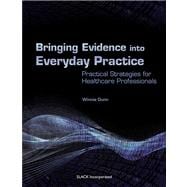
Note: Supplemental materials are not guaranteed with Rental or Used book purchases.
Purchase Benefits
Looking to rent a book? Rent Bringing Evidence Into Everyday Practice Practical Strategies for Healthcare Professionals [ISBN: 9781556428210] for the semester, quarter, and short term or search our site for other textbooks by Dunn, Winnie W.. Renting a textbook can save you up to 90% from the cost of buying.
| Dedication | |
| Acknowledgments | |
| About the Author | |
| Preface | |
| Foreword | |
| Introduction | |
| How to Use This Book | |
| Learning the Basics | |
| Introduction to Evidence-Based Practice | |
| Characterizing Responses to Evidence | |
| Understanding and Using the Basic Parts of Research Articles | |
| Practice Using Evidence to Design Best Practices | |
| Examining Evidence Related to Assistive Devices | |
| Examining Evidence Related to Use of Compensatory Strategies to Enhance Participation | |
| Examining Evidence Related to Caregiving | |
| Examining Evidence Related to Applying Sensory Processing Knowledge in Context | |
| Examining Evidence Related to Constraint-Induced Therapy Interventions | |
| Examining Evidence Related to Diet and Exercise | |
| Expanding Your Knowledge and Skills for Evidence-Based Practice | |
| Understanding Summary and Meta-Analysis Articles | |
| Examining Evidence Related to Emerging and Controversial Practices | |
| Creating Evidence Within Your Own Practice | |
| Bibliography | |
| Appendix Journal Articles for Activities | |
| The Role of Anomalous Data in Knowledge Acquisition: A Theoretical Framework and Implications for Science Instruction | |
| Barriers to the Use of Traditional Telephones by Older Adults With Chronic Health Conditions | |
| Efficacy of Sensory and Motor Interventions for Children with Autism | |
| The Influence of Vigorous versus Mild Exercise on Autistic Stereotyped Behaviors | |
| The Effects of Physical Exercise on Self-Stimulation and Appropriate Responding in Autistic Children | |
| The Effects of Exercise Intensity on the Stereotypic Behaviors of Individuals With Autism | |
| Decreasing Self-Stimulatory Behavior with Physical Exercise in a Group of Autistic Boys | |
| The Effects of Neurodevelopmental Treatment Versus Practice on the Reaching of Children With Spastic Cerebral Palsy | |
| Parent Reports of Sensory Symptoms in Toddlers with Autism and Those with Other Developmental Disorders | |
| The Effect of Training Older Adults With Stroke to Use Home-Based Assistive Devices | |
| Incorporating or Resisting Assistive Devices: Different Approaches to Achieving a Desired Occupational Self-Image | |
| Frail Older Adults' Self-Report of Their Most Important Assistive Device | |
| Removing Environmental Barriers in the Homes of Older Adults With Disabilities Improves Occupational Performance | |
| Randomized Controlled Trial of the Use of Compensatory Strategies to Enhance Adaptive Functioning in Outpatients with Schizophrenia | |
| Use of Environmental Supports Among Patients With Schizophrenia | |
| Caregiving and Autism: How Does Children's Propensity for Routinization Influence Participation in Family Activities? | |
| Mothers of Children With Disabilities: Occupational Concerns and Solutions | |
| Caregivers' Self-Initiated Support Toward Their Partners With Dementia When Performing an Everyday Occupation Together at Home | |
| The Effect of Constraint-Induced Movement Treatment on Occupational Performance and Satisfaction in Stroke Survivors | |
| Constraint-induced Movement Therapy for Hemiplegic Children With Acquired Brain Injuries | |
| From the General to the Specific: Using Meta-Analytic Reports in Clinical Decision Making | |
| Controversial Practices: The Need for a Reacculturation of Early Intervention Fields | |
| Controversial Therapies for Young Children with Developmental Disabilities | |
| Index | |
| Table of Contents provided by Publisher. All Rights Reserved. |
The New copy of this book will include any supplemental materials advertised. Please check the title of the book to determine if it should include any access cards, study guides, lab manuals, CDs, etc.
The Used, Rental and eBook copies of this book are not guaranteed to include any supplemental materials. Typically, only the book itself is included. This is true even if the title states it includes any access cards, study guides, lab manuals, CDs, etc.